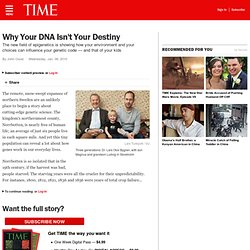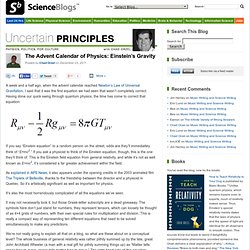

- StumbleUpon. Epigenetics, DNA: How You Can Change Your Genes, Destiny. The remote, snow-swept expanses of northern Sweden are an unlikely place to begin a story about cutting-edge genetic science.

The kingdom's northernmost county, Norrbotten, is nearly free of human life; an average of just six people live in each square mile. And yet this tiny population can reveal a lot about how genes work in our everyday lives. Norrbotten is so isolated that in the 19th century, if the harvest was bad, people starved. The starving years were all the crueler for their unpredictability. For instance, 1800, 1812, 1821, 1836 and 1856 were years of total crop failure... Subscribe Now Get TIME the way you want it One Week Digital Pass — $4.99 Monthly Pay-As-You-Go DIGITAL ACCESS — $2.99 One Year ALL ACCESS — Just $30! Scientists splice genes from roses and celery to create superflower. The idea of offering celery as a Valentine's Day gift to your loved one instead of chocolate might send the wrong message, but scientists working to improve the rose genome could make the low-calorie stem a popular Feb. 14 present after all.

It turns out that one particular gene from celery — the one that controls the enzyme mannitol dehydrogenase — greatly improves the life and quality of rose petals when that gene is spliced into the rose genome. So in an effort to help you get more value from your Valentine's Day gifts, North Carolina State horticultural scientists Dr. John Dole and Dr. John Williamson are leading an effort to insert that gene into roses to create a new superflower less prone to wilt and more resistant to disease, according to PhysOrg.com. "This gene is naturally found in many plants, but it's uncertain whether the rose already has it," said Williamson. Petal blight, or botrytis, is a common post-harvest disease in roses that produces wilty, mushy petals.
Scientists say nerves use sound, not electricity - Technology & Science - CBC News. Scientists Discover The Oldest, Largest Body Of Water In Existence. High speed video reveals the bizarre physics of an ordinary water droplet. Interactive 3D model of Solar System Planets and Night Sky - StumbleUpon. Biggest Scientific Breakthroughs of 2011. The Advent Calendar of Physics: Einsteins Gravity : Uncertain Principles. A week and a half ago, when the advent calendar reached Newton’s Law of Universal Gravitation, I said that it was the first equation we had seen that wasn’t completely correct.

Having done our quick swing through quantum physics, the time has come to correct that equation: If you say “Einstein equation” to a random person on the street, odds are they’ll immediatley think of “E=mc2.” If you ask a physicist to think of the Einstein equation, though, this is the one they’ll think of. This is the Einstein field equation from general relativity, and while it’s not as well known as E=mc2, it’s considered a far greater achievement within the field.
As explained in APS News, it also appears under the opening credits in the 2003 animated film The Triplets of Belleville, thanks to the friendship between the director and a physicist in Quebec. It’s also the most horrendously complicated of all the equations we’ve seen. What does this tell us? Photopic Sky Survey - StumbleUpon.